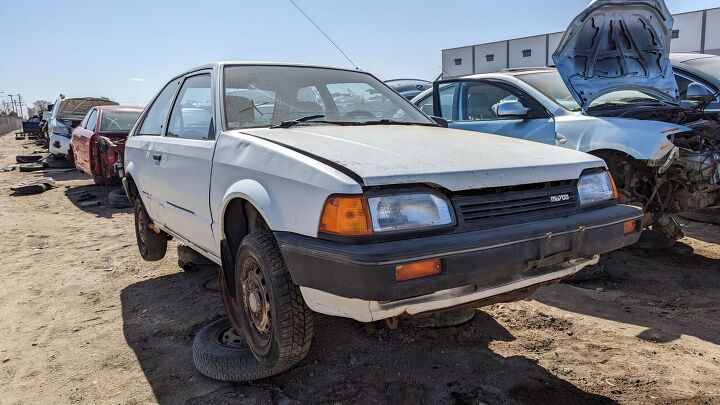Junkyard Find: 1988 Mazda 323 Base Hatchback

Six thousand 1988 dollars were worth about $15,822 in today's money, according to the United States Bureau of Labor Statistics, just below the MSRP of the cheapest new car available here now. In 1988, American car shoppers could choose among a dozen new cars priced below that figure. Today's Junkyard Find is a rare example of Mazda's entry in the sub-six-grand field for '88, found in a self-service yard in northeastern Colorado.
Stripped-down 1980s econoboxes with few or no options are nearly nonexistent today since their resale values tended to hit scrap-metal levels at about age 15.
This car had an MSRP of $5,999 ($15,820 in 2023 dollars), and I can't find a single extra-cost option on it.
Mazda began selling the second-generation Familia in North America in 1971, as the 1200 (with piston engine) and R100 (with Wankel engine). The fourth-generation Familia became the GLC (Great Little Car) here, first available as a 1977 model.
The fifth-generation Familia moved to a front-wheel-drive platform and debuted here as the 1981 GLC. North American GLC sales continued through 1985, and a facelifted Familia became the 323 here for 1986.
The Familia sedan became the Protegé here for the 1990 model year, while the 323 name remained on the hatchback through 1994. The final Familias sold here were the 2003 Protegés, after which the Mazda3 took over.
So, let's talk about price. The block-off plate where a right-side mirror might have lived tells us that the original buyer of this car wasn't willing to shell out any extra clams for frivolous extras.
The transmission is the 323 hatch's poverty-spec four-speed manual. The four-on-the-floor was available on new cars in the United States all the way through 1996 (in fact, three-speed manuals could be had in new cars here through 1981 and in light trucks through 1987), but was still considered suitable just for serious cheapskates by the late 1980s. Every configuration of the 1988 Mazda 323 available in the United States had a five-speed manual as standard equipment, except for the base three-door hatchback.
No power steering. No radio. No air conditioning. No cruise control. No tachometer. No rear window defogger (the defogger wires are embedded in the glass, but there's a block-off plate where the switch would have gone).
The very cheapest new 1988 car you could get in the United States was, of course, the $4,199 Yugo GV. The cheapest Hyundai Excel was just $5,295 that year. For (slightly) bigger spenders, the $5,490 Ford Festiva (a Mazda design built by Kia), $5,495 Chevrolet Sprint (Suzuki Cultus) and $5,556 Subaru Justy awaited.
Then you had a bunch of cars with prices from $5,899 through $5,999, including the Dodge/ Plymouth Colt, Dodge Omni/ Plymouth Horizon, Volkswagen Fox, and Toyota Tercel EZ. Knowing what we know now, if I had a time machine and orders to buy a new 1988 car under six grand, I'd take the Tercel EZ and its excellent build quality as my first choice, with the slightly-more-fun-to-drive 323 as a close second. Actually, I'd have insisted on $6,095 as the cutoff, putting the cheapest possible 1988 Honda Civic within my grasp.
This car made it to 195,372 miles during its life, which is pretty good for a throwaway commuter appliance bought on the cheap.
There's some rust-through in the usual areas, not so bad for a Japanese car of its era.
The keys are in the ignition, which might mean that this car was a trade-in that nobody wanted to buy. Note the row of switch block-off plates to the right of the steering column.
The Yugo, Justy, and Tercel EZ still breathed through carburetors for 1988, but even the lowliest new 323 came with electronic fuel injection at no extra cost that year. This engine was rated at 82 horsepower and 92 pound-feet.
Air conditioning would have added $760 to this car's cost (about $2,004 in 2023 dollars). An automatic transmission listed at $700 ($1,846 now). An AM/FM/cassette stereo cost $415 ($1,094 today). Power steering was $240 ($633). This car's original buyer was very disciplined about skipping options and pinching pennies.
If you wanted James Garner's choice in a new 323 SE sedan, the price started at $7,899 ($20,830 in 2023 dollars).
The 323+ hatchback gave New Brunswick Mazda shoppers a right-side mirror and a cassette deck at no extra cost.
Even the home-market ads got wailing guitars.
[Images: The Author]
Become a TTAC insider. Get the latest news, features, TTAC takes, and everything else that gets to the truth about cars first by subscribing to our newsletter.

Murilee Martin is the pen name of Phil Greden, a writer who has lived in Minnesota, California, Georgia and (now) Colorado. He has toiled at copywriting, technical writing, junkmail writing, fiction writing and now automotive writing. He has owned many terrible vehicles and some good ones. He spends a great deal of time in self-service junkyards. These days, he writes for publications including Autoweek, Autoblog, Hagerty, The Truth About Cars and Capital One.
More by Murilee Martin
Latest Car Reviews
Read moreLatest Product Reviews
Read moreRecent Comments
- Redapple2 All this BEV investment. A bigger impact (less oil consumption) would have been made if we had made PIG UP trucks smaller since 2000 and not HUGEr. (And raised gas tax by $2-3/gallon.)
- ChristianWimmer One of my clients is a company that is actually producing eFuels in Leipzig. Yes, they require a lot of energy to produce but this would not be an issue if Germany had nuclear energy or used the excess energy from wind and solar to produce these fuels. In such a scenario the energy losses wouldn’t really matter.Also, I am told that nations like Spain or the North African nations like Morocco or Tunisia could be ideal places to produce eFuels/Hydrogen due to their abundance of solar power. Again, the energy loses here would not matter since the energy used to produce these fuels is essentially “free”. If this path were pursued, Morocco and Tunisia could become wealthy nations and exporters of eFuels and Hydrogen. Countries with an abundance of solar or wind or hydro energy could be producing eFuels for their domestic consumption and export.Another argument which to me is irrelevant these days ist the poor thermal efficiency of ICE engines (25-35% gasoline, 40-45% diesel). One long trips with cruise control set to 130 km/h and even the occasional venture into the 180-200 km/h zone, my fully loaded (with my gear) A250 (2.0 4-cylinder 224-hp Turbo) can achieve an impressive gas mileage of 6 L / 100 km. That’s phenomenal - I am looking at six 1 liter bottles of water right now and that’s all my car needs to travel 100 km… amazing.So, I am a supporter of eFuels. I love internal combustion engines and if we want to use them in a climate neural way, then eFuels are a must. Also, to me every ICE car is way more sustainable and longer-lasting an an EV. Mazda, Toyota etc. are making the right move IMO.
- Blueice Once you infuse governmental unit regulation & [marketing] and taxpayerfunding, one knows quite well, dat the product or service isdestine to fail; which includes battery vehicles. Just axe yourself how revolutionary have your home batterydevices become ??? I am still waiting. after three decades, for a battery shaver whichonly requires charging two or three times per year.I am glad that I do not have a plug in Frau.
- Tassos Such a heavy breadvan on stilts, with so much HP, AND with ONLY 100 KWH Battery, I doubt if you will ever see 250 miles, let alone 300, under the best of conditions. In the winter, count on 150 miles range.And NO, it looks TERRIBLE. The only SUV that looks great is the RANGE ROVER.
- Tassos They sure are doing the right thing in the SHORT and MEDIUM term.As for the long term, in the long run, YOU'LL ALL BE DEAD, so WHO CARES.
















































Comments
Join the conversation
I just so happen to own a 1988 323, but it's not quite as barebones as this one. Has two mirrors, a/c, radio, and rear defrost. No power steering and no tach still. It's a surprisingly fun car to drive for 80hp.
Hearing me that 6 o’clock news anchor lady pronounce MAAAZ-DUH hurts my ears, brain and existence.
I grew up riding shotgun in my dad‘s green Mazda rotary pickup and got to see his friend auto cross his gorgeous, black Mazda RX3 rotary coupe. I even owned a hand me down bright red 1994 Mazda 323 in college and one of my frat brothers had a 1990 Mazda Protégé AWD. The company was called MAHZ-DA and they made interesting quality cars and trucks and still do.
I